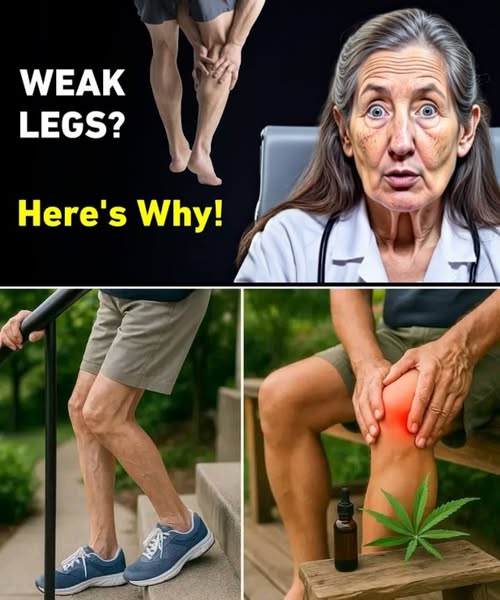Introduction
If you’ve recently noticed your legs feeling weaker, heavier, or less stable than they used to be, you’re not alone. Many people over 60 experience declining leg strength, which can affect mobility, independence, and overall quality of life. Weak legs are not simply a “normal part of aging”—they can signal underlying health issues or lifestyle habits that need attention.
The good news? With the right strategies, you can regain strength, stability, and confidence. In this article, we’ll uncover 6 surprising causes of weak legs after 60 and provide actionable solutions to help you stay strong and mobile for years to come.
1. Muscle Loss from Aging (Sarcopenia)
One of the most common—and often overlooked—reasons for weaker legs after 60 is sarcopenia, the natural loss of muscle mass with age. Research shows that adults lose 3–8% of muscle mass per decade after 30, and the decline accelerates after 60.
Signs of Sarcopenia:
- Trouble climbing stairs
- Difficulty standing up from a chair
- Feeling fatigued after short walks
What You Can Do:
- Strength training: Engage in resistance exercises 2–3 times a week. Bodyweight squats, step-ups, and light dumbbell exercises can make a huge difference.
- Protein intake: Aim for 1.0–1.2 grams of protein per kilogram of body weight daily to fuel muscle repair.
- Vitamin D: Low vitamin D contributes to muscle weakness. Check levels with your doctor and supplement if necessary.
👉 Key takeaway: Muscle loss is preventable. Strength training plus good nutrition can significantly slow down sarcopenia.
2. Poor Circulation and Peripheral Artery Disease (PAD)
Weak, heavy, or cramping legs may also be a result of poor blood circulation. In particular, Peripheral Artery Disease (PAD) affects about 12–20% of people over 60, restricting blood flow to the legs.
Symptoms of PAD:
- Leg pain while walking that improves with rest
- Cold or pale feet
- Slow-healing sores on legs or feet
What You Can Do:
- Walking program: Regular walking improves circulation and reduces PAD symptoms.
- Quit smoking: Smoking is a major risk factor for PAD.
- Medical care: Consult your doctor if symptoms persist—PAD increases the risk of heart attack and stroke.
👉 Key takeaway: Circulation problems can masquerade as leg weakness, so don’t ignore persistent symptoms.
3. Nerve Problems and Neuropathy
If your legs feel weak, tingly, or numb, the issue may stem from nerve damage—especially peripheral neuropathy, which becomes more common with age and conditions like diabetes.
Common Causes of Neuropathy:
- Diabetes (the leading cause)
- Vitamin B12 deficiency
- Spinal issues (e.g., herniated discs or spinal stenosis)
What You Can Do:
- Blood sugar management: Keep blood glucose within healthy ranges if you’re diabetic.
- Vitamin B12 intake: Include foods like eggs, fish, and dairy, or consider supplements.
- Posture and back health: Gentle stretches and physical therapy can relieve nerve compression.
👉 Key takeaway: If weakness is paired with numbness or tingling, nerve health may be at risk.
4. Sedentary Lifestyle
Sitting too much accelerates muscle weakness. Studies show that older adults who remain sedentary lose mobility twice as fast as active peers.
Signs Your Lifestyle Is Affecting Your Legs:
- Legs feel heavy after sitting for long periods
- Loss of balance when walking
- Reduced stamina with simple daily activities
What You Can Do:
- Daily movement: Stand up every 30 minutes. Even 5-minute walks can help.
- Low-impact activities: Swimming, tai chi, and cycling strengthen legs without stressing joints.
- Functional exercises: Practice standing from a seated position without using your hands.
👉 Key takeaway: Movement is medicine. The less you sit, the stronger your legs will stay.
5. Arthritis and Joint Problems
Joint stiffness and arthritis are common after 60 and can indirectly weaken your legs. When joints hurt, people naturally move less, leading to muscle loss.
Signs of Arthritis in the Legs:
- Morning stiffness that improves with movement
- Pain in knees, hips, or ankles
- Swelling or reduced range of motion
What You Can Do:
- Low-impact exercise: Swimming and elliptical machines reduce joint stress.
- Weight management: Even losing 10 pounds can take pressure off your knees.
- Anti-inflammatory diet: Focus on omega-3-rich foods like salmon, walnuts, and flaxseeds.
👉 Key takeaway: Managing arthritis keeps you moving—and movement keeps your legs strong.
6. Balance and Neurological Disorders
Sometimes, leg weakness after 60 is linked to neurological conditions like Parkinson’s disease, multiple sclerosis, or even early signs of stroke.
Warning Signs to Watch For:
- Sudden leg weakness on one side
- Tremors or difficulty coordinating movement
- Frequent falls or unsteady walking
What You Can Do:
- Medical evaluation: Don’t delay if weakness is sudden or severe—seek emergency care.
- Physical therapy: A tailored plan can improve coordination and prevent falls.
- Brain health habits: Stay mentally and physically active to reduce risks of cognitive decline.
👉 Key takeaway: Leg weakness can sometimes be a red flag for serious conditions—listen to your body.
Frequently Asked Questions (FAQs)
1. Is it normal for my legs to get weaker as I age?
Some decline in strength is common, but rapid or severe weakness is not normal. It often signals an underlying issue like sarcopenia, circulation problems, or nerve damage.
2. What vitamin is good for weak legs?
Vitamin D and B12 are especially important for muscle and nerve health. Magnesium and calcium also support muscle function.
3. Can walking strengthen weak legs?
Yes! Walking improves blood flow, builds endurance, and helps maintain muscle mass. Pair it with strength training for best results.
4. How do I know if my leg weakness is serious?
Seek medical help immediately if weakness comes on suddenly, affects only one side, or is accompanied by numbness, confusion, or trouble speaking—these may be signs of stroke.
5. How can I prevent my legs from getting weaker after 60?
- Stay active with strength and balance exercises
- Eat a nutrient-rich diet with adequate protein
- Monitor circulation and nerve health with regular checkups
- Address arthritis or joint pain early to maintain mobility
Conclusion
Leg weakness after 60 isn’t just about “getting older.” From sarcopenia and circulation problems to nerve damage and arthritis, there are multiple surprising causes—and, more importantly, effective solutions.
By staying proactive with exercise, nutrition, and medical checkups, you can preserve your independence, reduce fall risk, and continue enjoying the activities you love.
👉 Action step: If you’ve noticed your legs getting weaker, don’t ignore the signs. Start small with daily movement, add strength training, and talk to your doctor about underlying health issues.
Remember: Strong legs mean a stronger, longer, and more vibrant life.



